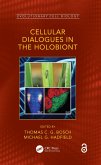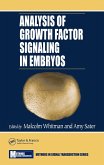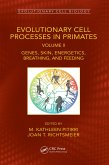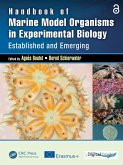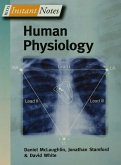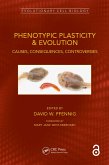333,95 €
333,95 €
inkl. MwSt.
Sofort per Download lieferbar

167 °P sammeln
333,95 €
Als Download kaufen

333,95 €
inkl. MwSt.
Sofort per Download lieferbar

167 °P sammeln
Jetzt verschenken
Alle Infos zum eBook verschenken
333,95 €
inkl. MwSt.
Sofort per Download lieferbar
Alle Infos zum eBook verschenken

167 °P sammeln
- Format: PDF
- Merkliste
- Auf die Merkliste
- Bewerten Bewerten
- Teilen
- Produkt teilen
- Produkterinnerung
- Produkterinnerung

Bitte loggen Sie sich zunächst in Ihr Kundenkonto ein oder registrieren Sie sich bei
bücher.de, um das eBook-Abo tolino select nutzen zu können.
Hier können Sie sich einloggen
Hier können Sie sich einloggen
Sie sind bereits eingeloggt. Klicken Sie auf 2. tolino select Abo, um fortzufahren.

Bitte loggen Sie sich zunächst in Ihr Kundenkonto ein oder registrieren Sie sich bei bücher.de, um das eBook-Abo tolino select nutzen zu können.
The purpose of this book is to provide information on senescent cells and why they are prevented from multiplying via cell division.
- Geräte: PC
- ohne Kopierschutz
- eBook Hilfe
- Größe: 8.9MB
Andere Kunden interessierten sich auch für
![Biology of Aging (eBook, PDF) Biology of Aging (eBook, PDF)]() Roger B. McDonaldBiology of Aging (eBook, PDF)61,95 €
Roger B. McDonaldBiology of Aging (eBook, PDF)61,95 €![Cellular Dialogues in the Holobiont (eBook, PDF) Cellular Dialogues in the Holobiont (eBook, PDF)]() Cellular Dialogues in the Holobiont (eBook, PDF)0,00 €
Cellular Dialogues in the Holobiont (eBook, PDF)0,00 €![Analysis of Growth Factor Signaling in Embryos (eBook, PDF) Analysis of Growth Factor Signaling in Embryos (eBook, PDF)]() Analysis of Growth Factor Signaling in Embryos (eBook, PDF)235,95 €
Analysis of Growth Factor Signaling in Embryos (eBook, PDF)235,95 €![Evolutionary Cell Processes in Primates (eBook, PDF) Evolutionary Cell Processes in Primates (eBook, PDF)]() Evolutionary Cell Processes in Primates (eBook, PDF)48,95 €
Evolutionary Cell Processes in Primates (eBook, PDF)48,95 €![Handbook of Marine Model Organisms in Experimental Biology (eBook, PDF) Handbook of Marine Model Organisms in Experimental Biology (eBook, PDF)]() Handbook of Marine Model Organisms in Experimental Biology (eBook, PDF)0,99 €
Handbook of Marine Model Organisms in Experimental Biology (eBook, PDF)0,99 €![BIOS Instant Notes in Human Physiology (eBook, PDF) BIOS Instant Notes in Human Physiology (eBook, PDF)]() Daniel McLaughlinBIOS Instant Notes in Human Physiology (eBook, PDF)26,95 €
Daniel McLaughlinBIOS Instant Notes in Human Physiology (eBook, PDF)26,95 €![Phenotypic Plasticity & Evolution (eBook, PDF) Phenotypic Plasticity & Evolution (eBook, PDF)]() Phenotypic Plasticity & Evolution (eBook, PDF)0,99 €
Phenotypic Plasticity & Evolution (eBook, PDF)0,99 €-
-
-
The purpose of this book is to provide information on senescent cells and why they are prevented from multiplying via cell division.
Dieser Download kann aus rechtlichen Gründen nur mit Rechnungsadresse in A, B, BG, CY, CZ, D, DK, EW, E, FIN, F, GR, HR, H, IRL, I, LT, L, LR, M, NL, PL, P, R, S, SLO, SK ausgeliefert werden.
Produktdetails
- Produktdetails
- Verlag: Taylor & Francis eBooks
- Seitenzahl: 280
- Erscheinungstermin: 11. August 2020
- Englisch
- ISBN-13: 9781000103014
- Artikelnr.: 59895616
- Verlag: Taylor & Francis eBooks
- Seitenzahl: 280
- Erscheinungstermin: 11. August 2020
- Englisch
- ISBN-13: 9781000103014
- Artikelnr.: 59895616
- Herstellerkennzeichnung Die Herstellerinformationen sind derzeit nicht verfügbar.
Eugenia Wang and Huber R. Warner
INTRODUCTION. POSITIVE CONTROL of CELL PROLIFERATION. The Regulation of
Cell Senescence. Expression of Growth-Related Genes in Senescent Human
Diploid Fibroblasts. Changes in Gene Expression during
Senescence/Immortalization of Mouse Embryo Fibroblasts. Nuclear
Responsiveness to Intracellular Signals in Normal and Senescent
Lymphocytes. Activation Defects in T Cells from Old Mice. Age-Re-lated
Differences in DNA Polymerase Alpha Specific Activity: Potential for
Interaction in DNA Repair. Characterization of Proliferating Cell Nuclear
Antigen (PCNA), or Cyclin, as a Cellular Marker for S-Phase Cells..
NEGATIVE CONTROL of CELL PROLIFERATION. Cellular Senescence: The Result of
a Genetic Program. Inhibitors of DNA Synthesis in Senescent and Quiescent
Human Diploid Fibroblasts. Growth Control in Cultured 3T3 Fibroblasts:
Molecular Properties of a Growth Regulatory Factor Isolated from
Conditioned Medium. Programmed Gene Expressions Suggest Multiple Blocks to
Replication during Cell Aging. GENERAL RELATED SUBJECTS. A Potential Role
for Interspersed Repetitive Sequence Elements in Negative Growth
Regulation. DNA Methylation, Maintenance CpG-Methylase, and Senescence.
Finite Proliferative Capacity of Syrian Hamster Fetal and Adult Fibroblasts
In Vitro: A Model System for the Analysis of the Cellular Basis of Aging.
Cellular Factors Related to Cessation of Proliferation and Differentiation.
Control of Muscle Differentiation by Mitogen: A Rationale for Multiple
Restriction Points in the Cell Cycle. SUMMARY. Index.
Cell Senescence. Expression of Growth-Related Genes in Senescent Human
Diploid Fibroblasts. Changes in Gene Expression during
Senescence/Immortalization of Mouse Embryo Fibroblasts. Nuclear
Responsiveness to Intracellular Signals in Normal and Senescent
Lymphocytes. Activation Defects in T Cells from Old Mice. Age-Re-lated
Differences in DNA Polymerase Alpha Specific Activity: Potential for
Interaction in DNA Repair. Characterization of Proliferating Cell Nuclear
Antigen (PCNA), or Cyclin, as a Cellular Marker for S-Phase Cells..
NEGATIVE CONTROL of CELL PROLIFERATION. Cellular Senescence: The Result of
a Genetic Program. Inhibitors of DNA Synthesis in Senescent and Quiescent
Human Diploid Fibroblasts. Growth Control in Cultured 3T3 Fibroblasts:
Molecular Properties of a Growth Regulatory Factor Isolated from
Conditioned Medium. Programmed Gene Expressions Suggest Multiple Blocks to
Replication during Cell Aging. GENERAL RELATED SUBJECTS. A Potential Role
for Interspersed Repetitive Sequence Elements in Negative Growth
Regulation. DNA Methylation, Maintenance CpG-Methylase, and Senescence.
Finite Proliferative Capacity of Syrian Hamster Fetal and Adult Fibroblasts
In Vitro: A Model System for the Analysis of the Cellular Basis of Aging.
Cellular Factors Related to Cessation of Proliferation and Differentiation.
Control of Muscle Differentiation by Mitogen: A Rationale for Multiple
Restriction Points in the Cell Cycle. SUMMARY. Index.
INTRODUCTION. POSITIVE CONTROL of CELL PROLIFERATION. The Regulation of
Cell Senescence. Expression of Growth-Related Genes in Senescent Human
Diploid Fibroblasts. Changes in Gene Expression during
Senescence/Immortalization of Mouse Embryo Fibroblasts. Nuclear
Responsiveness to Intracellular Signals in Normal and Senescent
Lymphocytes. Activation Defects in T Cells from Old Mice. Age-Re-lated
Differences in DNA Polymerase Alpha Specific Activity: Potential for
Interaction in DNA Repair. Characterization of Proliferating Cell Nuclear
Antigen (PCNA), or Cyclin, as a Cellular Marker for S-Phase Cells..
NEGATIVE CONTROL of CELL PROLIFERATION. Cellular Senescence: The Result of
a Genetic Program. Inhibitors of DNA Synthesis in Senescent and Quiescent
Human Diploid Fibroblasts. Growth Control in Cultured 3T3 Fibroblasts:
Molecular Properties of a Growth Regulatory Factor Isolated from
Conditioned Medium. Programmed Gene Expressions Suggest Multiple Blocks to
Replication during Cell Aging. GENERAL RELATED SUBJECTS. A Potential Role
for Interspersed Repetitive Sequence Elements in Negative Growth
Regulation. DNA Methylation, Maintenance CpG-Methylase, and Senescence.
Finite Proliferative Capacity of Syrian Hamster Fetal and Adult Fibroblasts
In Vitro: A Model System for the Analysis of the Cellular Basis of Aging.
Cellular Factors Related to Cessation of Proliferation and Differentiation.
Control of Muscle Differentiation by Mitogen: A Rationale for Multiple
Restriction Points in the Cell Cycle. SUMMARY. Index.
Cell Senescence. Expression of Growth-Related Genes in Senescent Human
Diploid Fibroblasts. Changes in Gene Expression during
Senescence/Immortalization of Mouse Embryo Fibroblasts. Nuclear
Responsiveness to Intracellular Signals in Normal and Senescent
Lymphocytes. Activation Defects in T Cells from Old Mice. Age-Re-lated
Differences in DNA Polymerase Alpha Specific Activity: Potential for
Interaction in DNA Repair. Characterization of Proliferating Cell Nuclear
Antigen (PCNA), or Cyclin, as a Cellular Marker for S-Phase Cells..
NEGATIVE CONTROL of CELL PROLIFERATION. Cellular Senescence: The Result of
a Genetic Program. Inhibitors of DNA Synthesis in Senescent and Quiescent
Human Diploid Fibroblasts. Growth Control in Cultured 3T3 Fibroblasts:
Molecular Properties of a Growth Regulatory Factor Isolated from
Conditioned Medium. Programmed Gene Expressions Suggest Multiple Blocks to
Replication during Cell Aging. GENERAL RELATED SUBJECTS. A Potential Role
for Interspersed Repetitive Sequence Elements in Negative Growth
Regulation. DNA Methylation, Maintenance CpG-Methylase, and Senescence.
Finite Proliferative Capacity of Syrian Hamster Fetal and Adult Fibroblasts
In Vitro: A Model System for the Analysis of the Cellular Basis of Aging.
Cellular Factors Related to Cessation of Proliferation and Differentiation.
Control of Muscle Differentiation by Mitogen: A Rationale for Multiple
Restriction Points in the Cell Cycle. SUMMARY. Index.


